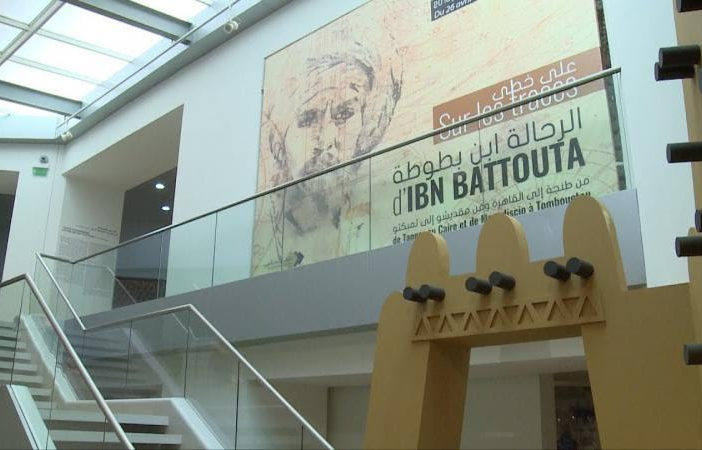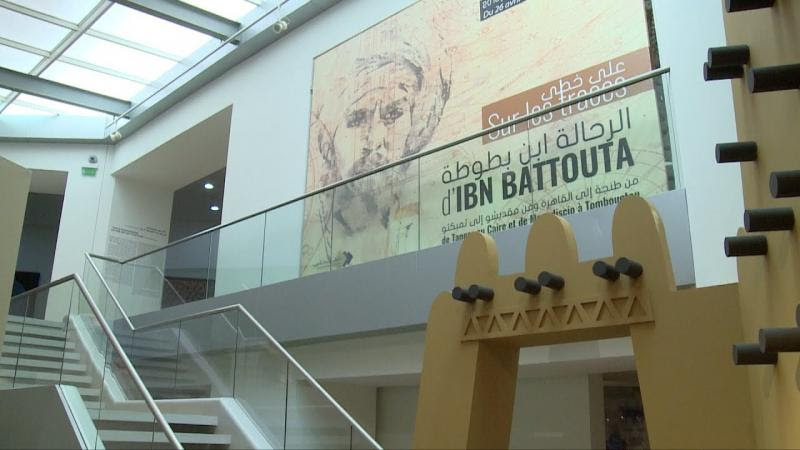The Arab Weekly
Saad Guerraoui
The exhibition at Bank Al-Maghrib Museum sheds light on Morocco’s historical and strategic ties.
In the footseps of Ibn Battuta. The entrance to the exhibition at Bank Al-Maghrib Museum. (Bank Al-Maghrib Museum)
RABAT – An exhibition celebrating Morocco’s most famous mediaeval traveller Ibn Battuta and his 14th-century ventures to the East and West Africa, the Mediterranean Basin, Andalusia and sub-Saharan Africa opened in Rabat and will remain on display until December.
The exhibition at Bank Al-Maghrib Museum pays tribute to Ibn Battuta’s travels and sheds light on the historical and strategic ties that Morocco enjoyed with several African countries during the 1300s.
“Not only does the exhibition aim to pay tribute to the work of this illustrious person but also to share a common and strategic history for the relations that Morocco had with its neighbours on the African continent at that time,” said museum Director Abderrahim Chaabane.
The exhibition highlights Ibn Battuta’s itinerary in North Africa, the Mediterranean basin, the eastern coast of Africa, Andalusia and Sudan. It depicts the most important events and conflicts that marked that time, including the power struggles to consolidate the independence of the various sultanates of the Abbasid Empire.
The exhibit features a variety of coins minted by monarchs Ibn Battuta met during his travels, maps showing his routes and excerpts from his book, “A Gift to Those Who Contemplate the Wonders of Cities and the Marvels of Travelling,” generally referred to as “The Travels.”
Ahmed Ettahiri, curator of the exhibition and research professor at the National Institute of Archaeology and Heritage Sciences, said Ibn Battuta, dubbed “the Great Traveller,” was a true adventurer who spent 29 years journeying throughout the Muslim world.
Some of the world’s famous travel quotes are on display, including Ibn Battuta’s “Travelling — it leaves you speechless at first before turning you into a storyteller” and Lebanese writer Amin Maalouf’s “Never hesitate to leave far, beyond all the seas, all the borders, all the countries, all the beliefs.”
A silver commemorative medal was coined for the exhibition and is available at the museum’s ticket booths and gift shop for 550 dirhams ($58).
This coin depicts Moroccan King Mohammed VI in addition to the words “Mohammed VI” and “Kingdom of Morocco,” with the vintages 2018-1439 on one side. On the reverse side is the inscription “Ibn Battuta” with the years “1304-1377” and a portrait of the great traveller.
The centre of the reverse includes a representation of the means of transport used during Ibn Battuta’s journeys and the inscription “120,000km,” which was the approximate distance of his trip, in addition to a map representing his travels.
The museum is organising a series of puppet show performances that illustrates, in a fun way, Ibn Battuta’s trips for the benefit of school groups. A conference, with three speakers who are researching Ibn Battuta, is scheduled for October.
Ibn Battuta spent many years on journeys that took him all over North Africa, the Middle East, the Arabian Peninsula, the western coast of Africa, Persia, South East Asia and China. Eventually he became homesick and longed for his birthplace.
He returned to Morocco by sea, visiting Sardinia on the way and stopping in Tunis and Algiers. Soon Ibn Battuta desired another trip. In 1350, he crossed Gibraltar Strait and toured the Bani Nasr kingdom before heading to Fez. There he joined a caravan heading to Sijilmassa on the northern edge of the Sahara Desert in Morocco. In 1353, Ibn Battuta crossed the Sahara towards what is today Mali and Niger.
Returning to Morocco in 1354, Ibn Battuta settled in the castle of the Marinid ruler Abu Inan Faris in Fez. The caliph was so captivated by Ibn Battuta’s tales of his travels that he ordered Ibn Juzayy to compile Ibn Battuta’s accounts into a manuscript, which he completed in 1357 and which was published as “The Travels.”
Written By
Saad Guerraoui
Saad Guerraoui is a regular contributor to The Arab Weekly on Maghreb issues.








